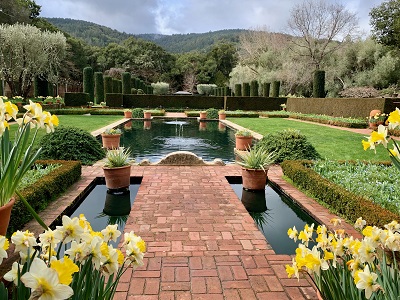~
Ballrooms and Butlers: The Grand Estates of the
San Francisco Peninsula
San Francisco Peninsula
Ginny Kubitz Moyer
Actually, it did.
In the late nineteenth and early twentieth centuries, the San Francisco Peninsula was home to dozens of lavish country estates. San Franciscans who made their money in mining, banking, utilities, or the railroad—or who inherited fortunes from fathers who had—found that a leisurely country lifestyle could be theirs in the rolling hills of the Peninsula. The infamous fog of San Francisco dissipates as one moves south, making the area even more enticing, and good railroad links ensured an easy commute back to offices in the city. These factors led to the proliferation of estates throughout present San Mateo County, on land that was previously inhabited by Mexican rancheros and, prior to that, by the Ohlone people.
Today, entering the world of these estates takes a fair amount of imagination. In researching The Seeing Garden, I marveled at how much the Peninsula has changed in one hundred and fifty years. Although some of the mansions still exist as private residences, many of the biggest estates were razed long ago to make way for housing or businesses. In the city of San Mateo, for example, the site of the estate owned by businessman Antoine Borel is now primarily shops and office buildings. There’s no trace of his large house or the pond and rocky walls that were built to look like the mountain passes of Borel’s native Switzerland.
One and a half miles north, a high-rise apartment building dominates the skyline at what was once the El Cerrito estate, the oldest one on the Peninsula. At the time of The Seeing Garden (1910), El Cerrito was owned by Eugene de Sabla, Jr., co-founder of Pacific Gas & Electric Company. Although the estate was eventually sold and subdivided, one lovely piece that remains is the Japanese garden commissioned by De Sabla. Designed by Makoto Hagiwara (who also designed the Japanese Tea Garden in Golden Gate Park), the garden is now part of a private residence on a suburban street. A plaque on the site notes that it is listed in the National Register of Historic Places, and its serene beauty can be glimpsed through the gates along the street.
 |
| Gates to the Japanese garden, formerly part of the El Cerrito estate |
In the nearby city of Belmont, Ralston Hall is a sleeping beauty of a mansion on the grounds of Notre Dame de Namur University. Once upon a time, it was the home of William Ralston, founder of the Bank of California. After Ralston’s death by drowning in San Francisco Bay in 1875, the house changed owners and at one point even served as a sanitarium. Now owned by the university, for many years it was available for event rentals. Sadly, it’s now closed, awaiting a fairy godmother philanthropist who can cover the cost of necessary seismic retrofits. Walking around the grounds offers a tantalizing glimpse of the mansion that counted Mark Twain among its guests.
 |
| Ralston Hall, the sleeping beauty |
Today, the most accessible of the estates is Filoli in Woodside. It was completed in 1917 for William and Agnes Bourn, and is now open to the public, inviting visitors to walk through the airy Georgian Revival house and savor the well-tended gardens. I was in my twenties when I first visited Filoli, on a spring day when the wisteria was in full bloom, and it felt like stepping into one of the novels I loved. That visit planted the seed which eventually turned into Oakview, the fictional estate in The Seeing Garden. While writing the novel, I visited the Filoli gardens often to see what would be blooming in different months. I’ve had few research experiences more enjoyable than that.
 |
| The Filoli Gardens |
Of course, it’s all too easy to focus on those who owned the big houses. In reality, the estates were kept afloat by fleets of gardeners, maids, butlers, housekeepers, and other employees. The kitchen at Filoli offers a display of census reports, showing the staggering number of people who worked there. Each estate was a microcosm of the larger society; class divisions were inescapable and much was owned by very few. Arguably, little has changed.
 |
| The Filoli mansion, Woodside, California |
But one of the joys of writing historical fiction is its sense of possibility. Imagination is free, research frequently is, and anyone who is inspired by a certain period can travel back in time through the act of storytelling. As I wrote The Seeing Garden, the Peninsula of the great estates was a captivating place to call home.
 |
| the author in the Filoli Gardens |
~
Ginny Kubitz Moyer is a California native with a love of local history. A graduate of Pomona College and Stanford University, she is the author of the new novel The Seeing Garden (She Writes Press). An avid weekend gardener, she lives in the San Francisco Bay Area with her husband, two sons, and one rescue dog. You can learn more about her at ginnymoyer.org.










No comments:
Post a Comment